Mysore Palace is the imperial palace of the royal kings of Mysore, Karnataka. The royal heritage palace is indeed a symbol of grandeur and elegance. Among the largest tourist attractions in India, Mysore Palace come second, just next to the Taj Mahal of Agra. Mysore Palace is also a testament of rich history and culture of the region. Precisely, the elegant palace attract the billions of tourists featuring stunning architecture and royal history of Mysore kings.
Mysore Palace showcases the proud history of the Wodeyar kings and their insignia. The Wodeyar dynasty of Mysore once had been the vassals of Vijayanagara Empire. Mysore Palace inside is full of artifacts, especially royal costumes, jewelry, weaponry, and vintage photographs etc. Each artifact represent a testimony of the rich history and cultures of the royal family of Mysore. Interestingly, the royal Wodeyar dynasty of Mysore is still living in the palace.
Mysore Palace is popular with other names, including Amba Vilas Palace, and Mysore Aramane in the city. The royal palace is very close to the Chamundi Hill, home to the esteemed Chamundeshwari Temple. The temple, dedicated to the goddess Chamundeshwari, the family deity of the royal Wodeyar family.
Mysore Palace Brief History
Mysore Palace prior to 1896 was an wooden palace. Earliest history of Mysore Palace dates back to 14th century. The old wooden palace of Mysore existed at the same place, inside an wooden fort. In 1638 CE, a lightning strike had damaged the first Mysore Palace badly. Mysore King, Maharaja Kantirava Narasaraja Wodeyar restored the wooden palace. He has also added new pavilions to it. But Tipu Sultan, who became the new ruler of Mysore in 1793, had demolished the old Mysore palace.
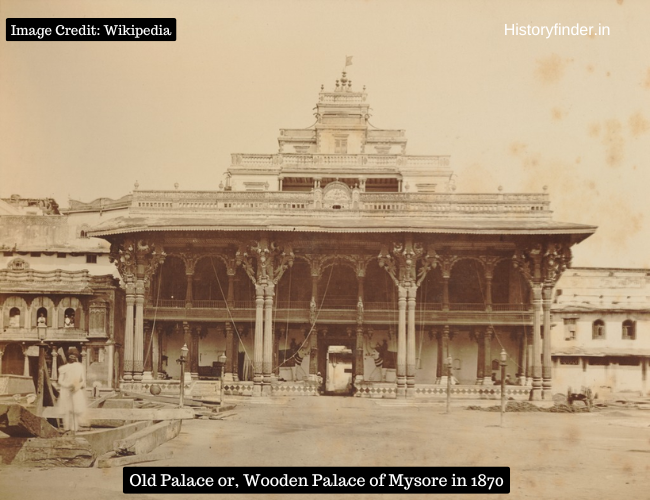
The death of Tipu Sultan in 1799 brought back the Wodeyar rule in Mysore. Maharaj Krishnaraja Wodeyar III ascended the throne of Mysore at the age of five years. Maharaj Krishnaraja Wodeyar III began a second Mysore Palace, again a pure wooden construction in Hindu structural style. The construction was finished in 1803. But, the second Mysore Palace also caught fire in 1896, during the wedding of Jayalakshammani, daughter of Maharaja Chamaraja Wodeyar.
Maharaja Krishnaraja Wodeyar IV, the 24th Wodeyar king, constructed the current Mysore Palace. Maharani Kempananjammanni Devi, his mother, also had valuable contributions. The grand construction of Mysore Palace took 15 long years. It started in 1897 and eventually finished in 1912.
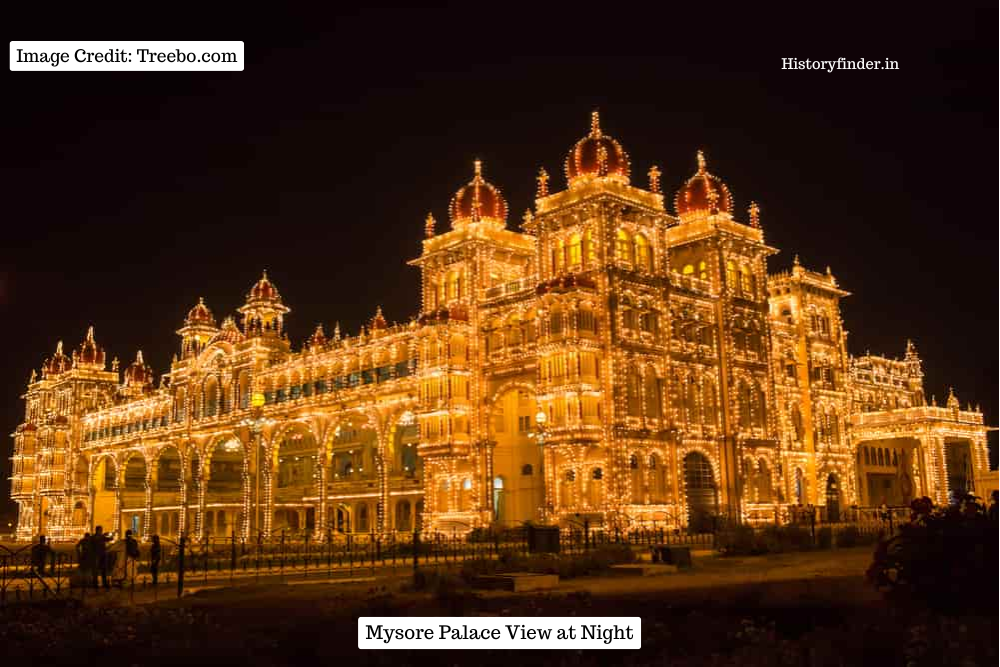
Historical Importance of Mysore Palace
Mysuru Palace, the royal palace of Mysore, is a significant historical landmark in the town. The 100 years old palace of Mysore holds a great historical significance. Mysore Palace architecture is a classic representation of Indo-Sarasenic architecture, a perfect blend of Hindu, Muslim, Rajput, and Gothic styles. Hence, the architectural elegance of Mysore Palace reflects a notable historical importance.
The royal Wodeyar dynasty ruled Mysore since 1399 CE. So, Mysuru Palace exhibits the insignia of the Wodeyars, including their patronage of art, culture, and religion. The intricate carvings, stunning domes, arches, and grand durbar hall of Mysore Palace symbolize royal grandeur of Wodeyar dynasty. Another historical importance of Mysuru Palace is Mysore Dasara, a 10 days royal celebration during Dussehra festival.
Mysore Palace houses a vast collection of priceless artifacts, including paintings, sculptures, weapons, and royal regalia. It offers notable insights into the opulence and history of the Wodeyar dynasty.
Mysore Dasara Festival: Blend of Tradition, Culture and Royalty
Mysuru Aramane history is extremely rich with the royal cultures of Mysore Kings. Mysore Dasara festival was actually the ceremonial tradition of the great Vijayanagara Empire. During 17th century, Wodeyar dynasty embraced the culture. The procession of Goddess Chamundeshwari represents the victory of good over evil. Mysore Dasara festival serves as a cultural spectacle, blending religious devotion, artistry, and the regal legacy of Mysore. Today, it remained a cherished symbol of Karnataka’s cultural pride.
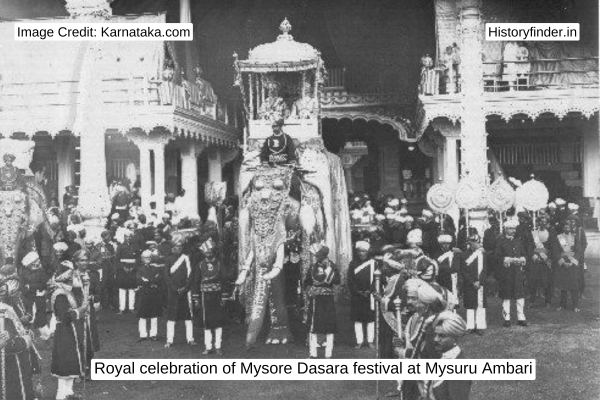
Mysore Ambari History
The Mysore Ambari, a golden howdah (ornamental elephant seat), symbolizes the rich heritage of Mysore. It is also the major attraction of Mysore Dasara festival. Crafted in 1917, this 750 kg masterpiece was commissioned by the Wodeyar dynasty. Since then Mysore Ambari had been the primary attraction of the famous Dasara festival of Mysore. The golden Mysore Ambari was built to carry idol of Goddess Chamundeshwari, the presiding deity of Mysore royal family.
Mysore Golden Howdah or Chinnada Ambari is a wooden structure, made with 84 kilograms of gold sheets and precious stones. The howdah is intricately designed with gold plating and adorned with traditional motifs, reflecting the grandeur of royal craftsmanship.
Mysore Palace Architecture
British architect Henry Irwin was appointed as the chief architect for the marvelous construction. He traveled to Delhi, Madras, Kolkata and studied several architectural specifications. Sir Henry eventually mixed traditional Indian styles with European Gothic styles to introduce Indo-Sarasenic Architecture. The century old architectural creativity still remained among the largest tourist attractions in India.
Indo-Sarasenic Architectures are widely noticeable since 19th century constructions in India. Glimpses of Hindu, Mughal, Rajput and Gothic style are visible in Mysore Palace architecture. Madras High Court, Victoria Memorial and Chhatrapati Shivaji Maharaj Terminus are among the other monuments having Indo-Sarasenic architecture.
The Royal Mysuru Palace construction cost was about 41 million Rupees (around $30 million) during that period.
The elegant 3-storied stone structure has marble domes on top, with beautiful large gardens surrounding it. A beautiful sculpture of goddess Gajalakshmi appears above the central arch. Whole palace is a beautiful amalgamation of styles from India and around the world. Palace has a five storied and 145 feet tall tower having colorful decoration.
Key Structures Inside Mysore Palace
All structures, interiors of Mysore Palace are carrying an incredible history of aristocracy of Wodeyar dynasty. Despite several demolition and destruction in its 600 years of history, Mysore Palace stood up strong every time.
- Entrance gates;
- Kalyana Mantapa;
- Public Durbar Hall;
- Ambevilasa Hall;
- Wrestling Courtyard
1. Entrance gates
Mysuru Aramane entrance gates carry similar regal charm of the Wodeyars. Jayamarthanda Gate, appearing at the eastern entrance is the main entrance of the elegant Mysuru Palace. The largest gate of Mysore Palace carries ornate design, with arches and traditional motifs. Jayamarthanda Gate, the gorgeous entrance mostly reserved for the dignitaries and the royal family. Anyway, the most beautiful entrance gate of Mysuru Aramane is used publicly during Mysore Dasara festival.

Varaha gate is the second important entrance of Mysore Palace, located at the south of the palace. The gate is called Varaha gate because the famous Varaha Swamy temple is located nearby. Historically, the gate has housed several ceremonial processions, especially the kings of Mysore Palace.
Balarama gate appears at the north of Mysore Palace. The gate is also rich in architectural detailing. Balarama gate is often used for public entry to the royal palace of Mysuru.
Elephant gate or Ane Bagilu exists at the west of the palace. With much simpler design compared to other gates, Elephant gate was build for administrative uses only. Administrative uses include elephant entries during Mysore Dasara festivals too.
2. Kalyana Mantapa or Wedding Hall
Kalyana Mantapa or Marriage Hall, an octagonal pavilion, is the most breathtaking part of Mysore Palace. Beautifully crafted interior of Mysore Kalyana Mantapa was built to host royal ceremonials in grand style. The magnificent stained-glass ceiling of Kalyana Mantapa has intricate floral motifs, predominantly in hues of gold, pink and peacock blue. The walls have many detailed oil paintings, enhancing the royal grandeur of Mysore Palace.
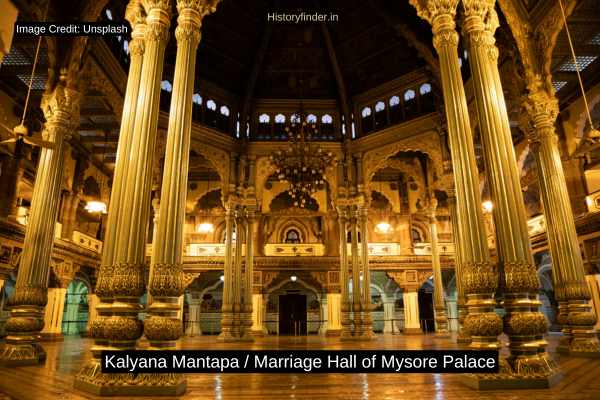
Mysore Palace Kalyana Mantapa interior reflects stunning another glimpse of Indo-Sarasenic architecture. Kalyana Mantapa design was made in Glasgow, Scotland. Four highly skilled Indian artists took more than 15 years to decorate the Mysore Palace Kalyana Mantapa interior. Richly decorated columns, painted in vibrant colors and gold accents are reflecting the regal grandeur of the Wodeyars.
3. Public Durbar Hall inside Mysore Palace
Mysore Palace Public Durbar Hall recites the proud history and reputation of Wadiyar dynasty. The large, intricately decorated public hall would conduct public hearings and court proceedings in king’s presence. Historically, Mysore Palace public durbar hall had made many state announcements from the royal family of Mysore. During British rule, the hall hosted many significant historical interactions too. In short, the Public Durbar of Mysore Palace continued to symbolize the cultural and historical legacy of the Wadiyar dynasty.

Mysore Public Durbar hall interior is the major attraction of the palace, especially the pillars with intricate carvings. Today, the majestic public hall offers a glimpse into the opulent governance and lifestyle of the Wodeyar kings.
Mysore Palace public audience hall has a very close association with Chinnada Simhasana, the famous golden throne. Mysore Chinnada Simhasana consists of 280 kilograms of solid gold, symbolizing the royal authority and pride of the Wodeyar dynasty. In 1610, Raja Wodeyar I discovered the throne in the temple town of Sringeri. Since then, the golden throne of Mysore remained the centerpiece of royal pride of Mysore. According to legends, it originally belonged to the Pandavas from the Mahabharata era. Even in current times, the Maharaja of Mysore ascends the golden throne on every Dussehra.
Public Durbar Hall opens from one side into an expansive balcony. A fine view of Chamundi Hills would definitely remove all weariness of Wadiyar Kings.
4. Amba Vilasa or Private Audience Hall
Mysore Palace private audience hall, Ambavilasa, was built to host the king’s confidential discussions. The private durbar of King would appear just next to the Public Durbar. Architecturally, Ambavilasa represented another glimpse of Indo-Sarasenic style with more detailed artwork. The gold plated columns, Venetian mirrors, and Belgian crystal chandeliers featuring Ambavilasa interior, exemplify the opulence of the Wodeyar dynasty.
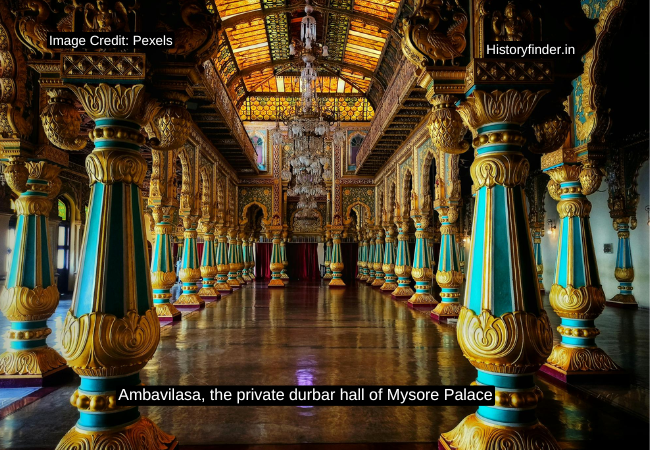
5. Wrestling Courtyard
The courtyard suggest the Wodeyar Kings had encouraged the game of wresting a lot. A class of wrestlers called ‘Jetties’ would only receive eligibility for the royal wrestling competition in Mysore Palace. The Wrestling Courtyard was specially constructed to organize such games.
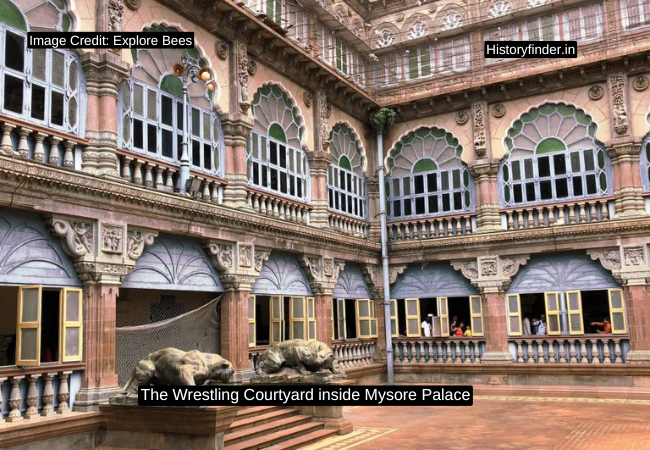
‘Vajramusti’ was the most famous rather cruel wrestling game called often exhibited by Jetties, especially during the Dasara festival of Mysuru.
Mysore Palace FAQ
Mysore is one of the biggest cities in the state of Karnataka and connected to the world easily. You can choose any mode of travel to visit the Mysore Palace at Mysore, Karnataka.
Air: Nearest Airport to the Palace of Mysore is Bangalore Airport. The airport is just 170 km from Mysore city.
Train: Mysore Railway station is the nearest Railway station to the Palace of Mysore.
Road: Mysore is very well connected to other cities of Karnataka and India by road.
Rs 40 for Indian citizens and Rs 200 for foreign citizens.
Palace is open for visitors from 10:00 am to 5:30 pm.
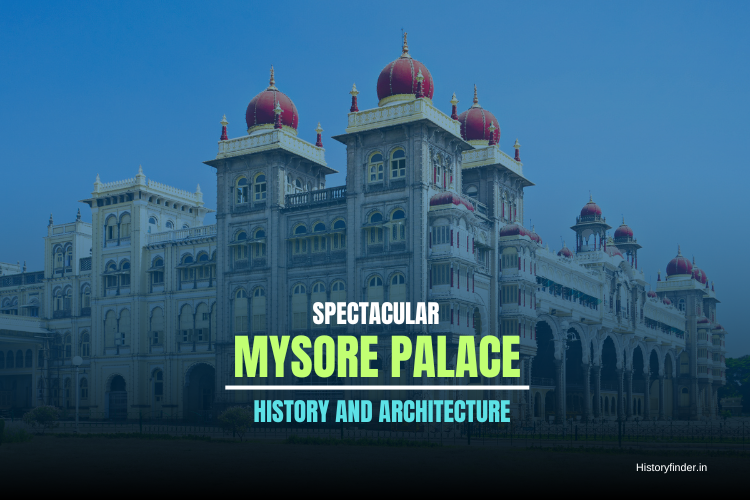
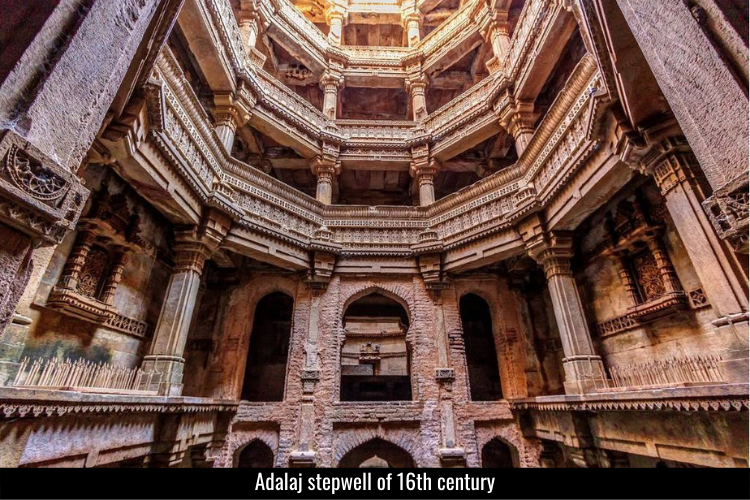
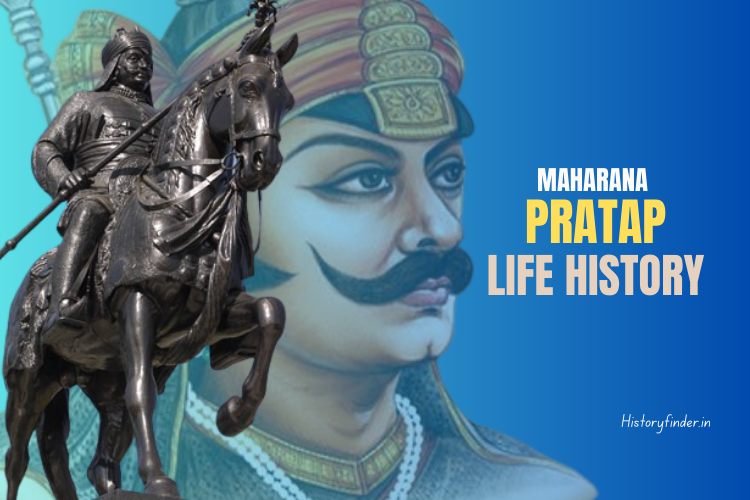
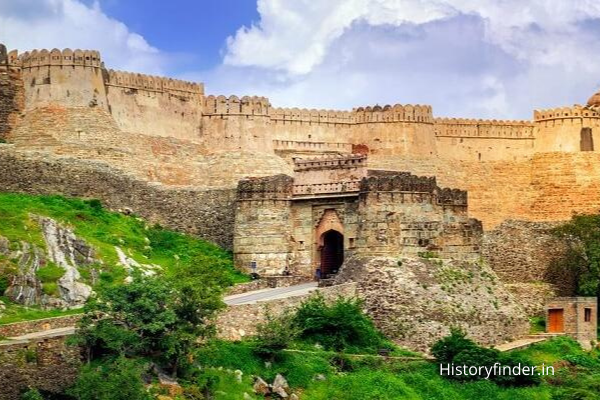
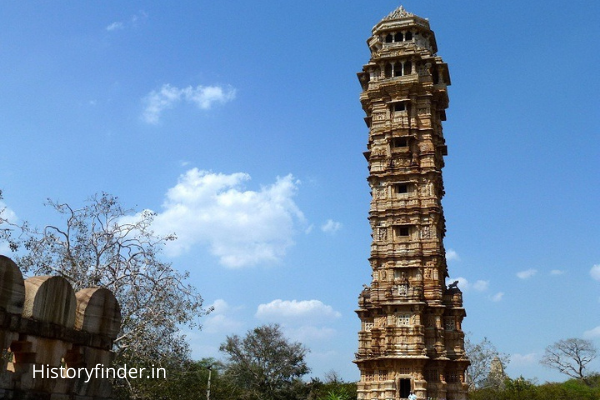
Pingback: Cooch Behar Palace history - History Finder
Pingback: Victoria Memorial Kolkata history and architecture - History Finder